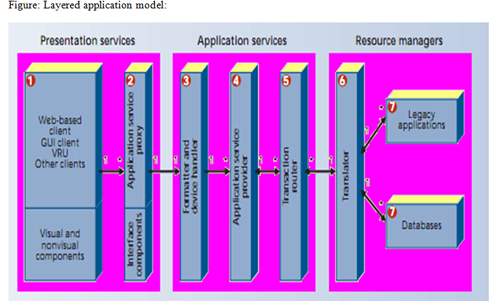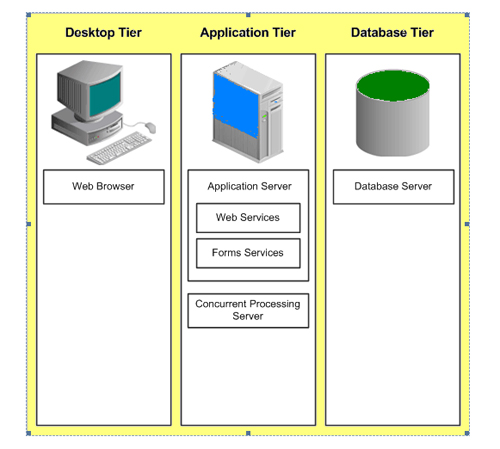E business Architecture (Management Information System)
E -Business is a comprehensive concept that generated dynamic and profound impacts on global business. Architecture can be explained in numerous ways as they can take many forms, including logical views, scenarios, physical views and deployment views. Each vision provides a particular type of information within the diagram and is directed to a certain audience that include Web architects, data architects, application architects and end users. Effective, consistent e-business architecture can serve as platform for upcoming e-business applications. To develop an e-business architecture, experts must ensure that they are developing and leveraging core components across manifold applications. Effectual e-business architecture should be built after a watchful analysis of the way a company does business. E-business architecture must be implemented in suitable manner for huge success. Current business framework must be considered while designing e-business architecture. It must be analysed that how they would like this structure to be if it's a new business, and from that point develop an architecture that will take the business to a next level of organization and management. E business architecture adopt Internet technologies and pioneering business processes to develop applications that expand beyond the conventional limits of time, space, departmental, organizational, and territorial borders. These solutions add value by cutting bottom-line costs through a lower cost of ownership, higher efficiencies, reduced transaction costs, and process improvements. They also lead to speedy development by helping companies to move faster, hold new markets, discover new distribution channels, and motivate creativity in their organizations. While e-business applications share many aspects with distributed client-server systems, they also have numerous differences
E-business Architecture Design
E-business architectures control Web technologies to execute mission-critical e-business applications. These architectures utilize small-footprint clients to access services, provided by resource managers that can be accessed across a strong and consistent system. These customers can be browsers running on personal computers, network devices, personal digital assistants, cell phones, and other pervasive computing devices. The e-business architecture is advanced technology and it is above range of existing online technologies and products. It comprises of numerous architectural models and plan in that it explains a proposal that will meet the current and future needs of a different client population, and will adjust to varying business and technology needs.
The key elements that assist influence an e-business architecture include
- The organization's overall e-business strategy.
- Business drivers such as time to market, conversation customer service, and others;
- The current IT environment.
- IT vision, objectives, and strategies.
- Organizational constraints such as staff, budgets, risk tolerance, and others.
- New and emerging technologies
E-business architectures must also be developed to meet a key set of operational requirement such as the scalability to support many users, the capacity to handle volume loads that can vary dramatically over time, acceptable transaction response times under most conditions, a secure computing environment that protects sensitive information from unauthorized access, and continuous system availability.
In order to develop highly organized engineered architecture, experts must begin with clear understanding of the current environment and a clear visualization for the future. Subsequently, they must develop an effective plan that will move from the current environment toward the future state by taking into account the resources available for the effort and developing a good understanding of the constraints under which these architectures must be developed.
Architects who build E business architectures must use the following guiding principles:
- Develop architectures based on open standards and technologies. It will assist professionals to shift the application to a different hardware platform, or segment the application's workload. To develop such flexibility, they must understand the services model and choose products based on open technologies that provide these services.
- Segment application architecture into different layers, then ensure the layers are tightly coupled internally and loosely coupled to the model's other layers. This approach will provide the flexibility to establish the proper placement for these layers on the physical tiers of the architecture.
- confirm the technologies used in these architectures are proven and stable.
- Leverage investments in existing systems. The strength of e-business applications comes from building original processes by integrating with existing systems and databases, not by reinventing them.
- In a rigid labour market, search experts with good technical skills are both hard and expensive.
- The services model and layered-application model can provide a supportive framework to execute these principles.
Logical-services model: This model gives a layout of the fundamental architectural components that deliver the services required to support e-business applications. These services assure the functional and operational requirements of the applications and the high-level interactions among them.
Layered-application model: Experts usually analyse and design specific e-business applications. They create business domains and draft the equivalent design documents that explain detailed software component models. These models operate with reference to the high-level models

When planning end-to-end e-business architecture, it is recommended to concentrate on the proper user interface, application, middleware, database design, tools, and deployment strategy. It will help in the analytical functions needed to reply user's query. The real value of an end-to-end e-business architecture lies in its ability to provide integration with back-end systems and databases.
The Oracle E-Business Suite Architecture is a structure for multi-tiered, distributed computing that holds Oracle E-Business Suite products. In this representation, various servers or services are distributed among three levels, or tiers.

E-business architectural model consists of supply and customer partnerships or interfaces. Supply alliances are those that associated with business processes, information technology and data needed for operations. Customer collaborations denote to the business processes, rules, data and information technology required for sales, marketing, customer service, customer support and business collaborators. Interactions in both types of collaboration may occur over the telephone, internet or face-to-face. The interfaces used within the e-business architectural model direct and guide applications a company uses to help ensure cost-effective business solutions. Such solutions will assist meet the enterprise's consistency, performance and scalability requirements in order to change response in volatile market.
Enterprise Level: E-business architectural model at the enterprise level is related to the strategic direction of an organization. This level assists influence business behaviours as well as supply and customer collaborations. In the enterprise level, supplier-facing processes facilitate make supply chains, integrated product development and procurement functional. It also helps purchaser collaborations in the field of sales, customer relations, customer contracts and marketing.
Functional Level: The functional level of the e-business architectural model is linked with the elements of a value chain and ascertains the main process-to-process relationships, including those that relate to customer collaborations, corporate functions, supply collaboration and value chains. This level depends on buyer to explore solutions, real-time reporting of a competitive analysis, the ability to incorporate new technologies and integrated data storage. E-business should use the same business processes throughout the functional level.
Operational Level: The operational level of the e-business architectural model deals with the detailing and certification of integrations and process definitions within the dissimilar value chains and process areas. The operational level the e-business architectural model describe implementation activities, process roles, control points, supporting applications and process roles in order to support reliability and assimilation by using the same web services, operating systems and using a theoretical view of communication within the architectural model instead of a physical view.
E-business Issues and Conflict
E-business system architecture development has various issues that are faced by working group for system architecture development:
- Changes in Market and their effects on the organization and on the objectives of the e-business.
- The historical inactivity caused by the independency of the businesses and their independent information management policies, architectures, and legacy systems.
- variable requirements and objectives for the E business development caused by changing markets, changing organization, and dissimilar conceptions in independent business units.
- Rising conflicts and problems develop from the market and organization changes, historical inertia, and moving objectives.
To summarize, the objective of the E Business Architecture is to give a flexible electronic business architecture that upholds a technology-neutral outlook where possible. E-business architecture is not only related with technology instead they use Internet technologies and inventive business procedures to develop applications that expand beyond the conventional limits of time, space, departmental, organizational, and territorial borders. These solutions add value by cutting bottom-line expenses through reducing cost of ownership, higher efficiencies, reduced operation costs, and process improvements. They also lead to growth through assisting companies to expand their business, hold new markets, discover new distribution channels, and encourage inventiveness in their organizations.

